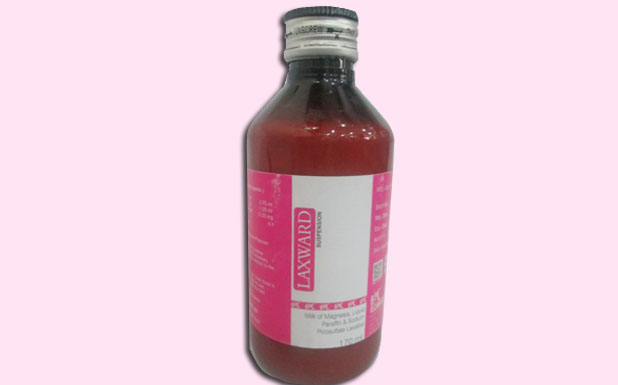Indications: Short term treatment of constipation associated with:
● Piles
● Anal Fissure
● Cardiovascular disorder
● Hernia
● Pre and Post operative condition
● Endoscopy
● Elderly and bed ridden patients
● Bowel clearance before radioscopy.
Pharmacological Properties:
Pharmacodynamics Properties:
Milk of Magnesia:
● Milk of magnesia is practically insoluble in water and solution is not effected until the hydroxide reacts with hydrochloric acid in the stomach to form magnesium chloride. Its neutralising action is almost equal to that of sodium bicarbonate. When the dose is in excess of that required to neutralise the acid the intragastric pH may reach pH 8 or 9. Acid rebound following magnesium hydroxide is clinically insignificant.
● Magnesium hydroxide has an indirect cathartic effect resulting from water retention in the intestinal lumen.
Sodium Picosulfate:
● Sodium picosulfate is a locally acting laxative from the triarylmethane group, which after bacterial cleavage in the colon, has a dual-action with stimulation of the mucosa of both the large intestine and of the rectum. Stimulation of the mucosa of the large intestine results in colonic peristalsis, with promotion of accumulation of water, and consequently electrolytes, in the colonic lumen. This results in a stimulation of defaecation, reduction of transit time and softening of the stool. Stimulation of the rectum causes increased motility and a feeling of rectal fullness. The rectal effect may help to restore the "call to stool" although its clinical relevance remains to be established.
● As a laxative that acts on the colon, sodium picosulfate specifically stimulates the natural evacuation process in the lower region of the gastrointestinal tract. Therefore, sodium picosulfate is ineffective in altering the digestion or absorption of calories or essential nutrients in the small intestine.
Liquid paraffin:
● When taken orally Liquid Paraffin acts as a lubricant and keeps the stools soft; it is useful in the treatment of constipation and in painful conditions of the anus and rectum such as haemorrhoids and anal fissure.
Pharmacokinetics:
Milk of Magnesia (Magnesium Hydroxide):
● Magnesium hydroxide exerts its antacid therapeutic effect rapidly within the gastro-intestinal tract following oral administration and this action is therefore independent of pharmacokinetic properties. Following oral administration, about one third to half the magnesium is absorbed very slowly from the small intestine. Magnesium salts are excreted mainly in the urine with small amounts in the faeces and saliva.
● Magnesium is important for many systems in the body especially the muscles and nerves. Magnesium hydroxide also reduces stomach acid, and increases water in the intestines which may induce defecation.
● Magnesium hydroxide is used as a laxative to relieve occasional constipation (irregularity) and as an antacid to relieve indigestion, sour stomach, and heartburn.
Sodium Picosulfate:
Absorption and Distribution: After oral ingestion, sodium picosulfate reaches the colon without any appreciable absorption. Therefore, enterohepatic circulation is avoided.
Biotransformation: Sodium picosulfate is converted into the active laxative compound, bis-(p-hydroxyphenyl)-pyridyl-2-methane (BHPM), via bacterial cleavage in the distal segment of the intestine.
Elimination: Following conversion, only small amounts of BHPM are absorbed and are almost completely conjugated in the intestinal wall and the liver to form the inactive BHPM glucuronide. After oral administration of 10 mg sodium picosulfate 10.4% of the total dose was excreted as BHPM glucuronide in urine after 48 hours. In general, urinary excretion decreases when higher doses of sodium picosulfate are being administered.
Liquid paraffin:
● Liquid paraffin is indigestible and is absorbed only to a limited extent following ingestion.
Contraindications: ● Hypersensitivity to any ingredient of composition.
● Acute abdominal surgery, intestinal obstruction, undiagnosed abdominal pain, pregnancy and lactation.
● Contraindicated in children.
Special Warning and Precautions: ● Do not use without a doctor's advice if you have stomach pain, nausea, vomiting only. ● Call your doctor at once if you have a sudden change in bowel habits that persists over a period of 2 weeks. ● Do not use this medicine without a doctor's advice if you are pregnant. ● Do not use for longer than 7 days without medical advice.
Interactions: ● Laxatives containing magnesium salt impair absorption of Tetracycline. ● Since sodium picosulfate increases the rate of gastrointestinal transit, it may affect the absorption of other orally administered drugs which are given concomitantly.
Undesirable Effects: ● Diarrhoea may occur which is dose related. ● Prolonged use or overdose of sodium Picosulfate can precipitate the onset of an atonic non functional colon and hypokalaemia. ● Small amount of magnesium gets absorbed in the circulation occasional toxicity in presence of kidney damage.
Pregnancy and Lactation: There are no adequate and well-controlled studies in pregnant and lactating women. As with all medicines, avoid during early pregnancy and during lactation or concere your doctor before taking any medicine
